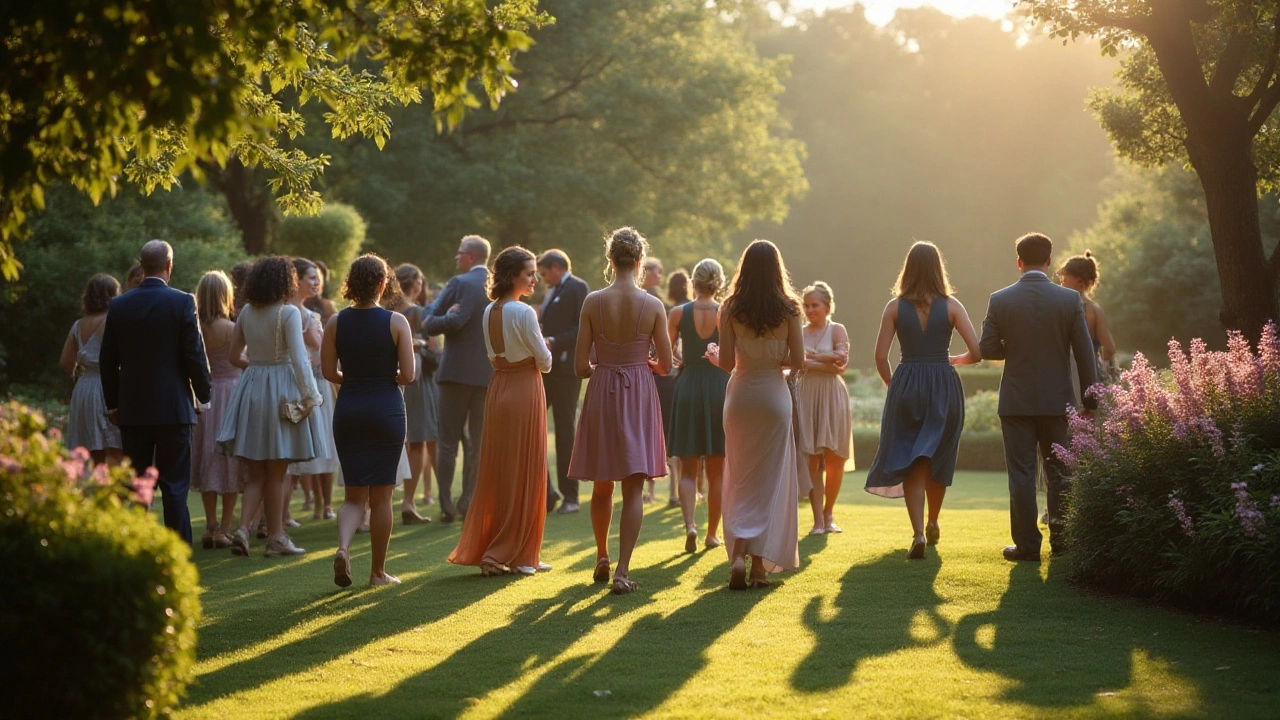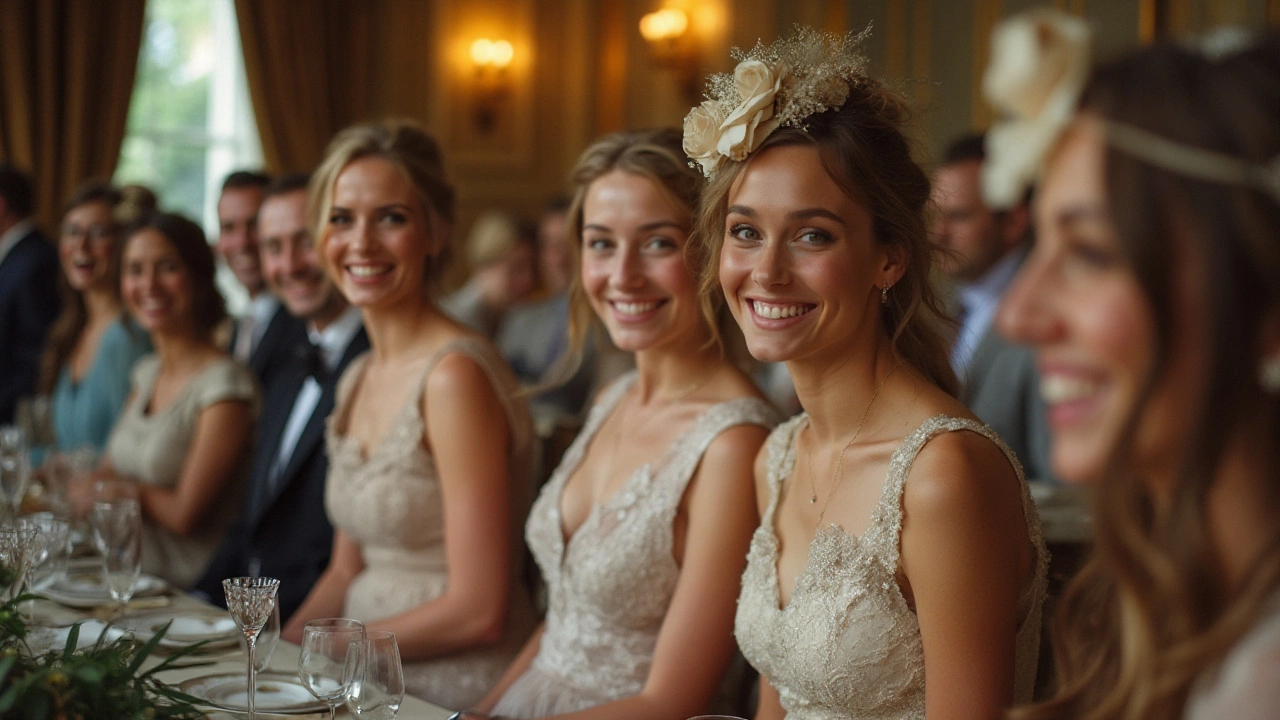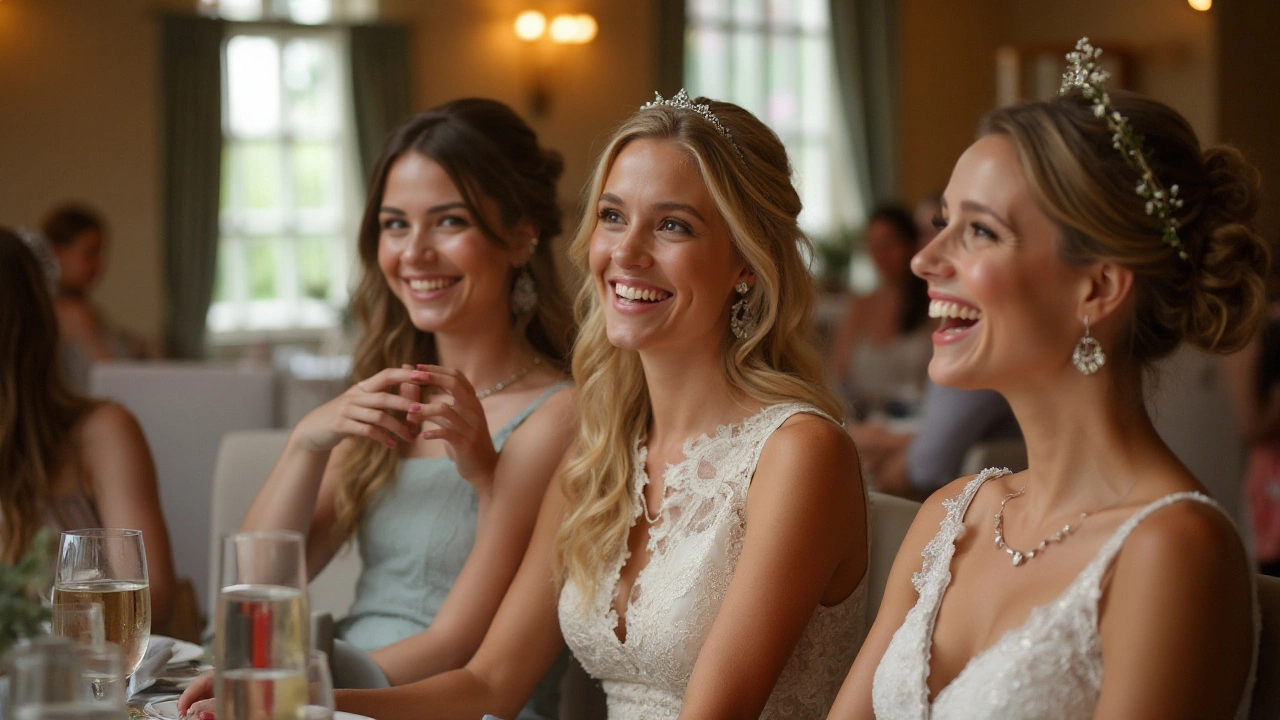Weddings are joyous celebrations, and choosing the right outfit is crucial in showing your appreciation for the couple's big day. While style and flair play a large role in your selection, the color of your attire holds a significant place in wedding etiquette.
There are hues that have long been considered no-gos at weddings, largely due to tradition and the desire to keep the focus on the bride and groom. Understanding these customs – and when exceptions might apply – can help you navigate your wardrobe choices with confidence.
- Traditional Colors to Avoid
- Cultural Sensitivities
- Exceptions to the Rules
- The Role of Seasonal Themes
- Tips for Choosing the Right Outfit
- The Importance of Respecting the Dress Code
Traditional Colors to Avoid
When it comes to wedding attire, certain colors are often tagged as inappropriate due to the cultural and social traditions they carry. While dress codes can vary by culture and location, there are some common hues universally recognized to make a faux pas on the big day. White tops the list as the ultimate no-go. Reserved for the bride, wearing white can inadvertently upstage her and draw unwanted attention. This unspoken rule is rooted in tradition and respect, maintaining the bridal figure as the center of attention. It's also generally suggested to steer clear of shades that are too similar to bridal whites, like cream or ivory, unless the invitation specifically indicates otherwise.
Another color guests are advised to avoid is black. Historically associated with mourning, black was often viewed as a somber choice for the celebratory nature of weddings. However, this notion has been evolving, with modern perspectives accepting black as a chic and versatile option, especially for evening weddings. Nevertheless, it is wise to gauge the formality and cultural background of the event before opting for this hue. A notable observation is that some cultures embrace black for weddings, rendering it perfectly acceptable.
"Traditional colors are like unwritten etiquette; they set the stage for the celebration. White belongs to the bride," says etiquette expert Emily Post.
Lastly, bright reds are another bold choice typically discouraged. In many Western cultures, red can be seen as too attention-grabbing, challenging the calming ambiance intended for the day. The vibrancy of red might overshadow the bride's attire or come across as a gesture for being too assertive, sometimes even being perceived as flashy. However, as with black, perspectives on red are evolving. As more couples embrace personal tastes over tradition, red can be acceptable, but it's crucial to consider the couple's preferences and cultural context.
Cultural Sensitivities
When attending a wedding, it's crucial to consider cultural sensitivities, which can influence what colors are deemed appropriate or inappropriate to wear. Across the globe, different cultures have varying beliefs and traditions that highlight the significance of certain colors. For instance, wearing white is typically reserved for the bride in Western weddings. It symbolizes purity and new beginnings, and wearing this color might be seen as trying to steal attention from the bride, which is considered quite disrespectful.
Similarly, in Chinese weddings, the color red holds a special place due to its association with joy and prosperity. Guests traditionally avoid wearing red so as not to overshadow the bride, who often wears either a red or brightly colored dress. This practice highlights how a basic understanding of cultural norms can help guests make informed decisions about their attire. Cultural sensitivity is more than just about avoiding the wrong colors; it’s about respecting the values and symbols that are important to the couple and their families.
In some Hindu ceremonies, the color black is often avoided for its association with mourning and bad luck. Guests are expected to wear vibrant colors like yellow, green, or orange, which signify happiness and new beginnings. Such cultural insights can prevent potential faux pas and ensure that your presence is in harmony with the event's traditions. In a Jewish wedding, guests might need to consider modesty more than the actual color.
Etiquette expert Emily Post once said, "Etiquette is the science of living. It embraces everything. It is ethics. It is honor." Understanding the nuances of etiquette in various cultures reflects the deeper respect we have for the unique traditions that enrich the world.
Another interesting fact is how seasons and regions can subtly impact acceptable wedding attire. In Japan, for example, darker colors are worn in formal settings and can sometimes be worn to weddings. However, the cherry blossom season inspires many to wear pastel colors, reflecting the natural beauty and fleeting nature of this iconic time of year. This practice is not only part of cultural sensitivity but also showcases how regional influences shape customs.
Even in Western weddings, where traditions are more flexible, one can't ignore the growing trend towards personalizing ceremonies with cultures from around the world. If you're attending a multicultural or fusion wedding, paying attention to the wedding invitation can offer vital clues about the preferred color palette and dress code. Our modern world is a tapestry of rich, colorful customs, and participating in these traditions with sensitivity and respect is a way to celebrate our shared humanity.

Exceptions to the Rules
Wedding attire involves its fair share of dos and don'ts, but as with most fashion rules, there are exceptions. While certain colors to avoid at weddings are generally accepted, circumstances can arise where breaking these norms might be entirely appropriate, or even requested by the couple themselves. For example, some modern couples challenge tradition by having their guests dress in white to create a unified, ethereal visual symphony. This bold choice speaks volumes to their unique style and helps weave their guests into the fabric of their love story.
Sometimes, culture plays a pivotal role in these exceptions. Take, for instance, Chinese weddings where red is traditionally worn by the bride. In this context, guests are sometimes encouraged to don shades of red to represent happiness and prosperity, which starkly contrasts with Western traditions where red might be seen as too attention-stealing. Moreover, individuality and personal relationships with the couple often dictate an exception. Long-time friends who might be part of the wedding party could find themselves in coordinating colors with the bride or groom, highlighting their unique bond.
Fashion trends can also create a shift in these unwritten rules. The rise of themed weddings and destination ceremonies often demands flexibility in guest attire choices. Imagine attending a beach wedding where the couple asks their guests to wear soft pastel shades to complement the serene ocean backdrop. Here, sticking rigidly to traditional wedding guest fashion norms might feel more out of place than embracing the theme. Even seasonal influences play their part; a winter wonderland wedding could call for richer, darker hues to embody the cozy and intimate atmosphere.
Ultimately, communication is key. Couples who wish for their guests to break from tradition typically include this in their invitation or through personal channels. It is essential, though, for guests to err on the side of caution and seek explicit confirmation before opting for colors like white, black, or other traditionally reserved shades. "The invitation serves as a window into the wedding," says Emily Post's Etiquette Institute, highlighting that details on attire will often be subtly woven between the lines.
The Role of Seasonal Themes
Seasonal themes play a subtle yet significant role in deciding the color palette for wedding attire. Each season brings with it a unique natural palette, often reflected in the themes chosen by couples for their wedding decor and ambiance. In spring, for instance, the colors usually lean towards soft pastels and floral accents, echoing the blossoming flowers and fresh beginnings of the season. This makes lighter shades like blush pinks, mint greens, and sky blues very popular and apt for a spring wedding. Choosing a wedding outfit that complements these hues not only aligns you with the wedding theme but also allows your style to harmonize with the setting.
Summer weddings open up a vibrant color spectrum. Bold, bright shades like corals, turquoise, and sunny yellows are not only encouraged but often celebrated, as they resonate with the sunny, warm climate. These colors are perfect for outdoor weddings, such as those at the beach or in a garden. As a wedding guest aiming to make a fashionable statement, it’s wise to embrace the vivacity of summer with an attire that includes splashes of these bright colors, provided they don't overshadow the bridal party's intended theme.
Autumn, with its rich and warm tones, offers a different set of must-avoid colors — think deep reds, browns, and golds. These are mirrors of nature's own wardrobe at this time of year and often include shades that are central to fall wedding themes. Opting for darker jewels like emerald green or burnt orange can effectively complement these colors, showing both foresight and respect for the natural setting the couple probably worked hard to incorporate. Respecting these themes not only ensures that you look great in seasonal photos but also demonstrates thoughtfulness toward the couple’s aesthetic vision.
In winter, the atmosphere is often defined by hues of deep midnight blues, icy silvers, and dazzling whites, representing the cooler weather. Outfits in these colors can look stunning against a snowy backdrop, especially when punctuated with bold accent colors like rich reds or royal purples. Winter weddings often feel more formal, so elegant fabrics such as velvet and satin are quite appropriate. Choosing a graceful outfit that pairs well with the winter theme will ensure both timeless photographs and contented smiles from the wedding couple.
A quote that rings true during any season comes from the famous fashion editor Diana Vreeland:
"The eye has to travel."This sentiment captures the essence of aligning your attire to the season, as it magnifies the travel of visual interest from the natural world into your choice of dress.
Understanding how seasonal themes influence wedding attire provides a roadmap for guests striving to strike the perfect balance between personal style and thematic consistency. By doing so, you're not simply aligning with the prevailing season; you're also honoring the couple's careful planning. Your inspired choice will surely resonate, both through the lens of the photographer and the appreciative eyes of those sharing the day with you.

Tips for Choosing the Right Outfit
When it comes to attending a wedding, choosing the perfect outfit can seem like a daunting task. There are a few simple tips that can help you pick attire that not only looks fabulous but also respects the couple's special day. First and foremost, consider the wedding attire guidelines shared by the hosts. These invitations often provide clues, whether explicitly or subtly, about the kind of setting and formality expected. If the invitation states black tie, semi-formal, or casual, use these terms as a baseline for what to wear.
Another critical element to consider is the wedding theme or location. A beachside ceremony will differ significantly from one held in an ornate ballroom. Dresses for a beach wedding might have a more relaxed, breathable design while gowns for ballroom events often lean toward the elegant and sophisticated. Similarly, consider seasonal factors; fabrics can make a huge difference in your comfort and the overall appropriateness of the attire. Lighter fabrics work best for summer, while wools or heavier materials could add that necessary warmth for winter nuptials.
Access to a little advanced planning can be your fashion savior—thinking ahead helps avoid last-minute outfit disasters. That's when you might also want to turn to a trusted photographer friend or fashion-savvy acquaintance to get a sense of what will look best not just in person, but also in those keepsake wedding photos. As Anja Winikka, a wedding expert, once remarked, "A guest should always aim to complement the landscape of the wedding, and never overtake it."
Anja Winikka, a wedding expert, emphasizes that guests should strive to complement the wedding landscape without overshadowing it.
Select colors thoughtfully. While we've mentioned some colors to steer away from, this doesn't mean you must go conservative entirely. Pops of color can be quite charming, especially if they harmonize with the wedding's bloom palette or motifs. Just be sure the hue doesn’t clash conspicuously or detract from the bridal party's attire. Take into account any cultural sensitivities that might be in play. What might be a happy color in one culture might have quite a different meaning in another.
For those who prefer a structured approach, here’s a quick guide to narrowing down your options: Start by choosing a color range that aligns with the season; next, refine this list based on the wedding's location and theme; incorporate the level of formality required; finally, add personal flair with accessories that spark joy without being distracting. All these steps ensure you won't just fit in, but also feel at ease, allowing you to genuinely enjoy the celebration. Crafting your perfect wedding guest outfit is less about finding the right dress and more about weaving these aspects into a coherent yet gorgeous ensemble. Remember, you’re there to celebrate love, so your attire should echo that joy and respect for the happy couple.
The Importance of Respecting the Dress Code
When invited to a wedding, respecting the dress code can seem like a given, but it's an aspect that holds much deeper significance than one might initially consider. First and foremost, adhering to the dress code is a way to honor the couple's vision for their day. Whether the theme is a black-tie affair, a relaxed beach gathering, or rural boho chic, each choice in attire contributes to the overall ambiance that the couple has thoughtfully curated for their celebration. By aligning with their wishes, you offer a silent nod to the time and effort they've put into planning.
Beyond honoring the couple, following the dress code is also about harmony and cohesion. Imagine turning up in a flashy, sparkly gown when the invite specified 'garden casual'. It would be akin to hitting a discordant note in an otherwise perfectly orchestrated symphony. Adhering to the suggested attire helps to ensure that everyone who forms part of the beautiful mosaic of guests complements the whole picture rather than drawing unnecessary attention to themselves. As David Tutera, a renowned wedding planner, once said,
"A wedding is an ensemble performance, and every guest has a role to play."The dress code is your cue card, providing instructions for your part.
Respecting the dress code shows respect not just towards the couple, but to fellow guests, too. It's about acknowledging the shared experience. No one wants the lingering self-consciousness that comes with doubt about their outfit choice when they arrive. By sticking to the outlined wardrobe guidelines, you can be confident that you're perfectly suited to the occasion and relate to others who have done the same. Conversations flow more freely when there's no undercurrent of discomfort or the awkwardness of 'being overdressed or underdressed', which is an unnecessary distraction from the joy of the event.
While there may be moments of rebellious temptation, particularly if you feel a certain dress code limits your personal style, it is worth remembering that these decisions reflect more than just fashion. They often harbor cultural or familial significance. For instance, certain colors may be off-limits because they are linked with traditional mourning colors or culturally inappropriate symbolism. Understanding such nuances and respecting them ensures a seamless blend of tradition, etiquette, and celebration, avoiding any form of unintentional offense to cultural sensitivities.
For those who find navigating a dress code tricky, there are plenty of resources and inspirations available online. Wedding blogs, fashion websites, and even conversations with the wedding party can provide guidance if you're feeling unsure. The couple's wedding hashtag can be a valuable tool, letting you peek at previous or similar events to get a sense of what's worked in the past. Incorporating the keywords from any theme provided and translating them into attire can actually open a beautiful gateway to creativity within given parameters. What's more, it can lead to unique styling opportunities you might not have considered on your own.
Living in an age where individuality and expression through fashion are celebrated, it can be easy to overlook why this tradition of specified dress persists. Yet, its enduring nature speaks volumes. Respecting the dress code isn’t just an act of compliance; it’s a gesture that's generous in spirit, a nod to the artistry behind a wedding, and a sincere way to appreciate and engage with what the day stands for. From the wedding attire that guests meticulously choose to every thoughtful detail laid before them, everything contributes to the timeless tapestry of love and unity being celebrated.
